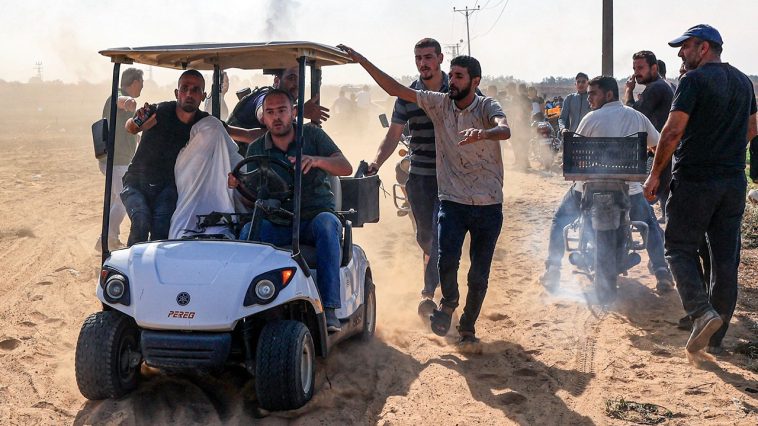On Sunday, the Palestinian group known as Hamas threw down a gauntlet, setting an expectation for their remaining hostages’ survival. Their demands include increased assistance for Gaza, along with prisoner swaps. This announcement followed an ongoing period of sustained losses in their continuing conflict with Israel.
Abu Obeida, speaking for Hamas’ military branch, conveyed a grim promise: unless Israel accepts every demand put forth, not a single captive will exit Gaza alive. The negotiations between the two parties collapsed in early December, but not before facilitating the liberation of over 100 individuals in a prior agreement.
In stark contrast, it seems that an approximate twenty individuals captured by Hamas have not been so fortunate, passing away during their detention. Israel released this tragic figure over the weekend. In a recent Saturday demonstration in Tel Aviv, families of the estimated 137 still detained in Gaza gathered in large numbers to plead for their loved ones’ release.
An accusation has been laid against Israel by Hamas too, suggesting that the former’s consistent airstrikes in northern Gaza have directly resulted in the death of several hostages.
Yet, Israel quickly dismissed these accusations as pure propaganda, further stating that Hamas has stooped to a new low by holding onto the bodies of the deceased. This reprehensible act, it is claimed, is a strategic move seeking to use these bodies as bargaining chips in the presently stalled negotiations. Ultimately, Hamas hopes that Israel will concede to demands of freeing more Palestinian prisoners and sending greater aid to Gaza.
Despite this deadlock, a glimmer of hope emerged last month. During a week-long ceasefire, over 100 hostages were released. However, when a proposed eighth exchange of prisoners could not be agreed upon, the conflict resumed on December 1. The cessation period served as a brief respite, temporarily suspending the horrors of conflict.
In the days that have followed the rekindling of hostilities, the Gaza Strip has witnessed massive damages. According to the Israel Defense Forces, over 3,500 targets linked to Hamas have been neutralized. The overall destruction count since the beginning of the war in early October is staggering, with over 22,000 targets destroyed, an outcome of the deadly surprise attacks launched by Hamas against Israel.
With Israel’s recent offensive advances in both northern and southern Gaza, there’s speculation that Hamas might be nearing its breaking point. Senior officials within the Israel Defense Forces suggest that the scope of destruction has impaired Hamas’ command and control, leaving certain Gazan regions out of its effective military jurisdiction. Nevertheless, they caution that the fight could potentially escalate as Hamas continues its resistance.
After close to two months of relentless engagement, including successful assaults and demolition of multiple Hamas headquarters in Northern Gaza, Israel Defense Forces are now concentrating their efforts toward the south, particularly around Khan Younis, the region’s largest city. Civilians define this city as a safe haven, with hundreds of thousands of Palestinians migrating post-evacuation orders in the north.
Amongst the decimated buildings in northern Gaza was the residence of Hamas leader, Yahya Sinwar. Considered the mastermind behind the mass-slaughter on October 7 that claimed over 1,200 Israeli lives, Sinwar escaped the onslaught. He is believed to have taken refuge in an aid vehicle before entering one of Khan Younis’s many underground passages, further complicating his capture.
Witness accounts confirm that the war continues to take a devastating toll. Concurrently, Israel’s campaign has resulted in the neutralization of about half of Hamas’ 24 battalion leaders, and an estimated 7,000 Hamas fighters. The death count, often featuring innocent civilians, remains high. Gaza’s associated Health Ministry estimates that the war has claimed over 17,700 lives, the majority being women and children. The controversial assertion of an IDF spokesperson, who labeled the ratio of terrorist-to-civilian deaths as ‘positive’, sparked much debate.
Meanwhile, the U.S. Secretary of State, Antony Blinken, encourages Israel to take further measures in avoiding civilian deaths in the conflict. He expressed concerns over the dire situation, urging Israel to implement longer breaks in actions to allow time for civilians to retreat and additional aid to reach the nearly two million displaced Palestinians.
Despite reservations and concerns about Israel’s approach to managing the war, Antony Blinken acknowledges the Jewish state’s independent choices on how it conducts the war and when it ends. Statements coming from Blinken affirm periodic discussions with Israel about the campaign’s duration and mechanisms, however, he comprehensively states that the final decisions rest with Israel.
Hamas also bears a part in the decision-making process, as Blinken states. He suggested that the group could retreat from exploiting civilians for cover, cease military activities, or surrender outrightly, ending the conflict. He defended the U.S.’s decision to bypass a congressional vote on selling nearly 14,000 tank ammunition rounds to Israel, pointing out that these were a minuscule portion of Israel’s requirements. He also called on Congress to approve a 100-billion-dollar aid bill for Israel, Ukraine, and other national security interests.
As the hostilities continue with no certain end in sight, the ashes of war lie heavy on the hearts of those involved. Each side harbors hopes, fears, and deeply ingrained convictions. The international community watches on with bated breath, hoping for a swift and peaceful resolution to the crisis.



